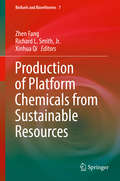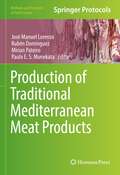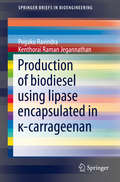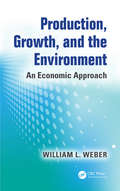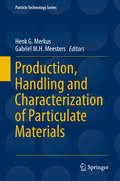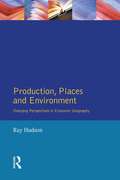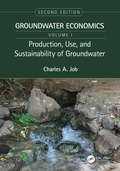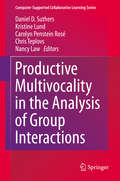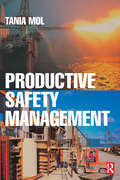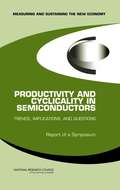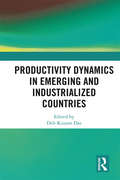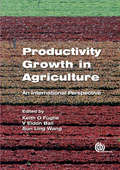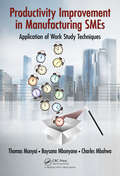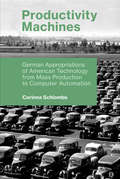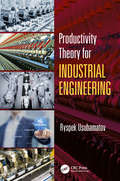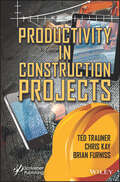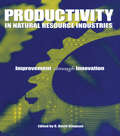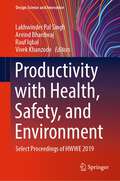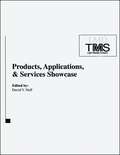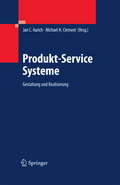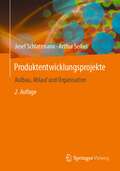- Table View
- List View
Production of Platform Chemicals from Sustainable Resources
by Richard L. Smith Jr. Zhen Fang Xinhua QiThis book provides state-of-the-art reviews, the latest research, prospects and challenges of the production of platform chemicals such as C6 sugars, 5-hydroxymethylfurfural, furfural, gamma-valerolactone, xylitol, 2,5-furandicarboxylic acid, levulinic acid, ethanol and others from sustainable biomass resources using processes that include heterogeneous catalysis, ionic liquids, hydrothermal/solvothermal, electrochemical and fermentation methods. It also discusses the application of these chemicals and their derivatives for synthesizing commodity chemicals via various routes. Intended as a reference resource for researchers, academicians and industrialists in the area of energy, chemical engineering and biomass conversion, it provides a wealth of information essential for assessing the production and application of various biomass-derived platform chemicals using biological, chemical and electrochemical techniques.
Production of Traditional Mediterranean Meat Products (Methods and Protocols in Food Science)
by José Manuel Lorenzo Paulo E. S. Munekata Rubén Domínguez Mirian PateiroThis volume details the inventory and characterizes traditional meat products within each geographic region. Consisting of 21 chapters, chapters guide readers through comprehensive descriptions of the materials and processing conditions used to make each meat product so that it can be manufactured by other researchers or industries. In addition, each book chapter includes explanatory notes and elucidate the possible specific points to take into account for the correct manufacture. Authoritative and cutting-edge, Production of Traditional Mediterranean Meat Products aims to standardize the manufacturing process of the main Mediterranean traditional meat products, since there are several variations between manufacturers or regions.
Production of biodiesel using lipase encapsulated in κ-carrageenan
by Pogaku Ravindra Kenthorai Raman JegannathanThis book explores a novel technique for processing biodiesel using lipase immobilization by encapsulation and its physical properties, stability characteristics, and application in stirred tank and re-circulated packed bed immobilized reactors for biodiesel production. The enzymatic processing of biodiesel addresses many of the problems associated with chemical processing. It requires only moderate operating conditions and yields a high-quality product with a high level of conversion and the life cycle assessment of enzymatic biodiesel production has more favourable environmental consequences. The chemical processing problems of waste water treatment are lessened and soap formation is not an issue, meaning that waste oil with higher FFA can be used as the feedstock. The by product glycerol does not require any purification and it can be sold at higher price. However, soluble enzymatic processing is not perfect. It is costly, the enzyme cannot be recycled and its removal from the product is difficult. For these reasons, immobilized enzymatic process has been developed which retains the advantages of the soluble enzymatic process and reuse of the enzyme is possible which decreases the enzyme cost, the biodiesel produced does not contain any enzyme residue and the activity of the enzyme can be increased by immobilization. The drawbacks of the immobilized enzyme process are mass transfer limitation, enzyme leakage, the lack of a versatile commercial immobilized enzyme and some of immobilization methods involve toxic chemicals. To overcome the drawbacks of the immobilized enzyme, an attempt is made to use a degradable biopolymer (κ-carrageenan) as a carrier for lipase immobilization.
Production, Growth, and the Environment: An Economic Approach
by William L. WeberWritten in a way that facilitates understanding of complex concepts, laws, and policy, Production, Growth, and the Environment: An Economic Approach explores how economic growth usually makes people better off, but also asks at what environmental cost? These costs are not often realized until after the fact, when their remediation is more expensive
Production, Handling and Characterization of Particulate Materials
by Henk G. Merkus Gabriel M. H. MeestersThis edited volume presents most techniques and methods that have been developed by material scientists, chemists, chemical engineers and physicists for the commercial production of particulate materials, ranging from the millimeter to the nanometer scale. The scope includes the physical and chemical background, experimental optimization of equipment and procedures, as well as an outlook on future methods. The books addresses issues of industrial importance such as specifications, control parameter(s), control strategy, process models, energy consumption and discusses the various techniques in relation to potential applications. In addition to the production processes, all major unit operations and characterization methods are described in this book. It differs from other books which are devoted to a single technique or a single material. Contributors to this book are acknowledged experts in their field. The aim of the book is to facilitate comparison of the different unit operations leading to optimum equipment choices for the production, handling and storage of particulate materials. An advantage of this approach is that unit operations that are common in one field of application are made accessible to other fields. The overall focus is on industrial application and the book includes some concrete examples. The book is an essential resource for students or researchers who work in collaboration with manufacturing industries or who are planning to make the switch from academia to industry.
Production, Places and Environment
by Ray HudsonDrawing upon 25 years of original research, Production, Places and Environment provides a unique combination of rich, varied and theoretically informed case studies, along with more general analyses of processes and changing theoretical and methodological perspectives in economic geography that are informed by original empirical research.Through a huge range of his own groundbreaking case material the author explores such essential factors as space, production, social and political concerns, and environmental issues, being careful to ground the more complex theory in the more general tendencies in economic geography and the social sciences.
Production, Use, and Sustainability of Groundwater: Groundwater Economics, Volume 1
by Charles A. JobGroundwater is becoming increasingly scarce while the demand for water continues to grow at a global scale. Understanding groundwater resources and their sustainable management is imperative for the future of groundwater use, conservation and protection. This revised and updated two-volume set, focused on sustainability, covers the economic values of groundwater production and use, including micro- and macroeconomic factors, groundwater markets, economic evaluation tools, climate change, transboundary issues and policy evaluation. It explores numerous applications and describes ways to evaluate the economics of groundwater use in the context of the larger ecosystem and the natural capital it provides. FEATURES OF THIS VOLUME Includes an important new chapter on groundwater sustainability management Addresses new examples of groundwater use that are applicable at both the local and international levels Provides the foundation for policy, program and project analysis for all major uses of groundwater Updates groundwater use data along with explanations of major production costs and use benefits Gives a new perspective on users’ competition for the subsurface environment Production, Use, and Sustainability of Groundwater, Second Edition, the first volume of the two-volume set Groundwater Economics, is a must-have for any professional or student who needs to understand, evaluate and manage water resources from a range of production and use perspectives affecting groundwater resource sustainability.
Productive Multivocality in the Analysis of Group Interactions
by Nancy Law Kristine Lund Daniel D. Suthers Carolyn Penstein Rosé Chris TeplovsThe key idea of the book is that scientific and practical advances can be obtained if researchers working in traditions that have been assumed to be mutually incompatible make a real effort to engage in dialogue with each other, comparing and contrasting their understandings of a given phenomenon and how these different understandings can either complement or mutually elaborate on each other. This key idea applies to many fields, particularly in the social and behavioral sciences, as well as education and computer science. The book shows how we have achieved this by presenting our study of collaborative learning during the course of a four-year project. Through a series of five workshops involving dozens of researchers, the 37 editors and authors involved in this project studied and reported on collaborative learning, technology enhanced learning, and cooperative work. The authors share an interest in understanding group interactions, but approach this topic from a variety of traditional disciplinary homes and theoretical and methodological traditions. This allows the book to be of use to researchers in many different fields and with many different goals and agendas.
Productive Safety Management: A Strategic, Multi-disciplinary Management System For Hazardous Industries That Ties Safety And Production Together
by Tania MolUnlike most books on this subject, Productive Safety Management, described in this book, integrates occupational health and safety, human resource management, environmental management, and engineering to provide a whole-business approach to effective safety management.The book helps companies to reduce and manage risk by providing, analysing and improving systems in place within the company. It also looks at how external factors can affect company decision making and provides a tool to make sure that a health and safety management system is strategically aligned, appropriately resourced, and that it maximises employee commitment. Chapters on human resource management explore cultural issues and explain how to gain commitment to company objectives.The book has been written for managers and supervisors working in hazardous industries, OHS practitioners, undergraduate and postgraduate students.
Productive Safety Management: How to Mitigate Residual and Entropic Risks, Second Edition
by Tania Van der StapThis book discusses the realm of operational risk management, exploring the intricacies of managing safety, production and quality simultaneously. It offers a fresh perspective on the dynamic and complex nature of risk, highlighting the ever‑changing landscape that organisations must navigate. The reliance on current understandings of residual risk is deficient, particularly as systems of production are prone to degradation over time. This degradation leads to an increase in ‘entropic risk’, resulting in losses in daily production that, if left unchecked, could culminate in catastrophic consequences.Productive Safety Management, second edition utilises practical experience to offer context and application to the concepts surrounding risk that are introduced. It explores the residual and entropic risks present in production systems before shifting focus to the same risks within organisational elements such as leadership, competencies, management systems and resilience. The degradation of these factors can lead to a toxic enterprise culture. Traditional risk management methods have resulted in the creation of functional silos. This book advocates for a multidisciplinary approach, positioning it as essential reading for the Fourth Industrial Revolution. In this era, the ability to effectively manage risks and capitalise on opportunities will be crucial for operational success.This comprehensive title is designed for operational managers and supervisors, and risk‑related professionals in engineering, OSH, environment and quality management.Tania Van der Stap spent the last 20 years since writing the first edition of Productive Safety Management in managerial and technical positions responsible for safety, health and environmental management. Having experience in staff and contractor roles means she understands how to achieve results, whether within the organisation, owners’ team, project team or as an external technical expert. The industries and organisations she’s worked in have been diverse – gas, mining, exploration, construction, rail transport, engineering, agribusiness, professional organisations and regulatory authorities. She has in‑depth knowledge of different strategies according to each organisation’s level of maturity, leadership capability, resource availability and most importantly, the operational reality of the enterprise. Tania’s qualifications are in commerce, which have throughout her career resulted in a business lens on operational performance. She is an unequivocal advocate of a risk‑ and opportunity‑based approach to HSE, production and quality.
Productivity And Cyclicality In Semiconductors: Trends, Implications, And Questions
by Committee On Measuring Sustaining the New EconomyHosted by Harvard University’s Kennedy School of Government, this symposium brought together leading technologists and economists to review technical challenges facing the semiconductor industry, the industry’s business cycle, the interconnections between the two, and the implications of growth in semiconductors for the economy as a whole. This volume includes a summary of the symposium proceedings and three major research papers. Topics reviewed encompass the industry technology roadmap, challenges to be overcome to maintain the trajectory of Moore’s Law, the drivers of the continued growth in productivity in the U.S. economy, and economic models for gaining a better understanding of this leading U.S. industry.
Productivity Dynamics in Emerging and Industrialized Countries
by Deb Kusum DasThe world, of late, has seen a productivity slowdown. Many countries continue to recover from various shocks in the macro business environment, along with structural changes and inward looking policies. In contemporary times of growth slumps, various exits and protectionist regimes, this book engages with the study of productivity dynamics in the emerging and industrialized economies. The essays address the crucial aspects, such as the roles of human capital, investment accounting and datasets, that help understanding of productivity performance of global economy and its several regions. This book will be of interest to academics, practitioners and professionals in the field of economic growth, productivity and development studies. This will also be an important reference on empirical industrial economics in both India and the world.
Productivity Growth in Agriculture
by Ms Sun Ling Wang Eldon Ball Dr Keith O FuglieIncreasing food prices have renewed concerns about long-run agricultural demand and supply in the global economy. This book looks at results, methods, and data on international agricultural productivity for a better understanding of long-run trends and the policies that determine them. By presenting an international assessment of total factor productivity growth in agriculture, including up-to-date empirical analysis for developed and developing countries and regions, it provides a response to the rising global scarcity of agricultural production. Essential reading for researchers, policy makers and students.
Productivity Improvement in Manufacturing SMEs: Application of Work Study
by Charles Mbohwa Thomas Thinandavha Munyai Boysana Lephoi MbonyaneThis book focuses on the application of workstudy in productivity of manufacturing SMEs locally and abroad and also explores various industrial problems which face manufacturing SMEs in developing and underdeveloped countries in the rest of the world. Low productivity is currently a serious challenge facing manufacturing SMEs, where these SMEs are operating below expected production output levels which makes it difficult for them to compete in the global market. SMEs are the engine drivers of economic growth, one of which is manufacturing. The challenge is that government from various countries in developing and underdeveloped countries, mandated agencies in their respective areas, to ensure that there is economic progress for these SMEs, but productivity remains low in the manufacturing SMEs. When SMEs do not perform well, productivity of manufacturing SMEs declines and unemployment increases. Thus, an increase in unemployment results in a drop of GDP in the country and can become a global and economic crisis. This book describes a process which enables the reader to use effective knowledge that addresses problems facing the productivity of manufacturing SMEs such as work study tools and case studies and provides solutions and applications to improve the running of the manufacturing SMEs in growing their productivity.
Productivity Machines: German Appropriations of American Technology from Mass Production to Computer Automation (History of Computing)
by Corinna SchlombsHow productivity culture and technology became emblematic of the American economic system in pre- and postwar Germany.The concept of productivity originated in a statistical measure of output per worker or per work-hour, calculated by the US Bureau of Labor Statistics. A broader productivity culture emerged in 1920s America, as Henry Ford and others linked methods of mass production and consumption to high wages and low prices. These ideas were studied eagerly by a Germany in search of economic recovery after World War I, and, decades later, the Marshall Plan promoted productivity in its efforts to help post–World War II Europe rebuild. In Productivity Machines, Corinna Schlombs examines the transatlantic history of productivity technology and culture in the two decades before and after World War II. She argues for the interpretive flexibility of productivity: different groups viewed productivity differently at different times. Although it began as an objective measure, productivity came to be emblematic of the American economic system; post-World War II West Germany, however, adapted these ideas to its own political and economic values. Schlombs explains that West German unionists cast a doubtful eye on productivity's embrace of plant-level collective bargaining; unions fought for codetermination—the right to participate in corporate decisions. After describing German responses to US productivity, Schlombs offers an in-depth look at labor relations in one American company in Germany—that icon of corporate America, IBM. Finally, Schlombs considers the emergence of computer technology—seen by some as a new symbol of productivity but by others as the means to automate workers out of their jobs.
Productivity Theory for Industrial Engineering (Systems Innovation Book Series)
by Ryspek UsubamatovSince the time of the Industrial Revolution, manufacturing industries have accumulated a huge experience in creating different machines and systems for fabricating various goods, work parts, and products. All these diverse machines and systems, with different designs to solve pivoted economic problems, increased the productivity rate of manufacturing processes and generated high-quality products. In the area of productivity theory for industrial engineering, there are numerous publications that describe the fundamental approaches and the mathematical models of productivity rate for the different designs of industrial machines and systems. Known theories consider the physical productivity rate as the number of products fabricated over a given time (ASME) that is a component of economic productivity. However, known mathematical models are simplified with assumptions and not well developed analytically, which can lead to severe errors in computing the output of manufacturing systems. Modern industrial machines and systems are complex in design and in structure with serial, parallel, and serial-parallel arrangements, and any failure of any component leads to downtime of expensive production systems. For this reason, industries need a productivity theory that enables accurate predicting of the output of manufacturing systems at the preliminary stages. Key features Offers fundamental principles of productivity theory for industrial machines and systems based on mathematics, technology, design, reliability, probability, and management Presents the conceptual principles of productivity theory for industrial machines and systems Provides methods for computing productivity losses in real industrial environments Closes the gap between theory and practice for computing productivity rates of manufacturing systems Incudes a comparative analysis of productivity rates for manufacturing systems of serial, parallel, and serial-parallel arrangements Productivity Theory for Industrial Engineering presents analytical approaches and methods to define maximal productivity rates, optimal machining regimes, and optimal structure of manufacturing machines and systems based on the parameters of technological processes, structural design, reliability of mechanisms, and management systems. This book uses productivity theory for solving productivity problems and can also be used for complex approaches for sustainable improvement of production processes.
Productivity in Construction Projects
by Ted Trauner Brian Furniss Chris KayPRODUCTIVITY IN CONSTRUCTION PROJECTS From planning/design to post-construction, this valuable guide provides the construction industry the key to understanding the importance of properly tracking and measuring productivity, resulting in increased efficiency and profitability for contractors, subcontractors, owners, civil and construction engineers, and attorneys. Productivity in Construction Projects anticipates and answers the questions of owners, contractors, sub-contractors, and construction professionals to avoid cost overruns in a specific area of work, or when activities are taking more resources to perform than planned. Packed with real-world case studies, Productivity in Construction Projects’ thirteen chapters move beyond the symptoms and provide a remedy. This book provides a comprehensive look at how to: Complete more projects on time and budget, and earn greater profits and future business. Track and analyze productivity on construction projects, and quantify additional costs resulting from productivity losses. Select the right experts and attorneys should litigation or arbitration occur, and employ credible and reliable methods of analysis. Solve problems on the project instead of incurring lengthy and costly litigation or arbitration.
Productivity in Natural Resource Industries: Improvement through Innovation
by R. David SimpsonSeveral senior natural resource analysts study the role played by innovation, particularly technological innovation, in the pursuit of heightened productivity. Increasing the output of a given input improves a firm‘s bottom line, makes it more competitive internationally, and reduces the potential for resource depletion and shortages. Thus, high productivity is a necessary ingredient of economic prosperity. This book illustrates the importance of technological innovation in achieving an acceptable level of output and efficiency. In this important new offering, a team of resource scholars describes and chronicles the development of recent innovations in selected natural resource industries. The authors also reveal the causes, sources, and net effect of such innovation on productivity. In all of these sectors productivity has increased considerably since the early 1980s, although the level of improvement varies across industries. To what degree did technological innovation contribute to that increase? Individual detailed case studies detail important innovations in America‘s coal, petroleum, copper, and forest industries. The primary focus is on extraction and production technologies, although the existence and importance of innovation in other areas such as management technique also enter the picture. For example, the combination of new technology with restructuring seems to have breathed new life into a floundering U.S. copper industry. The authors describe the origin and diffusion of important innovation, and the concluding chapter quantifies the net effect of such innovation on productivity.
Productivity with Health, Safety, and Environment: Select Proceedings of HWWE 2019 (Design Science and Innovation)
by Rauf Iqbal Vivek Khanzode Arvind Bhardwaj Lakhwinder Pal SinghThis volume comprises select proceedings of the International Conference on Humanizing Work and Work Environment organized by the Indian Society of Ergonomics (HWWE2019). The book presents research findings on different areas of ergonomics for developing appropriate tools and work environment considering capabilities and limitations of working people for maximum effectiveness on their performance. This volume will be of interest to academics, professionals and practitioners in the field of ergonomics.
Products, Applications, and Services Showcase
by The Minerals Metals Materials SocietyThis collection of short technical and product presentations is from the Products, Applications, and Services Showcase, a symposium focusing on the commercial aspect of the materials science and engineering professions.
Produkt-Service Systeme
by Jan C. Aurich Michael H. ClementBisher haben sich produzierende Unternehmen auf Entwicklung, Produktion und Vertrieb von Sachprodukten konzentriert, inzwischen fragen Kunden jedoch zunehmend komplette Problemlösungen nach. Unternehmen stehen vor der Herausforderung, den Wandel zum Full-Service Provider zu vollziehen. In dem Band wird ein Managementsystem zur Unterstützung von Planung, Entwicklung, Konfiguration und Realisierung von Produkt-Service Systemen (PSS) im erweiterten Wertschöpfungsnetzwerk vorgestellt und Methoden zur Organisation sowie zum Kompetenzerwerb aufgezeigt.
Produktdatenmanagement – Anforderungen und Lösungen: Konzeption, Auswahl, Installation und Administration von PDM-Systemen
by Thomas MechlinskiProduktdatenmanagement (PDM) ist ein umfassendes, in seiner Ganzheit schwer zu überblickendes Thema. Bei der Betrachtung gängiger PDM-Systeme stellt sich oft die Frage, warum bestimmte Funktionen und Eigenschaften existieren und wie sich damit typische Fragestellungen des Produktentstehungsprozesses (PEP) lösen lassen. Dieses Buch formuliert Anforderungen, die die heute am Markt erhältlichen PDM-Systeme abdecken und erklärt, auf welche Weise die Anforderungen erfüllt werden können. Der Katalog an Anforderungen ist auf die industrielle Praxis im Umfeld der Serienfertigung von Produkten zugeschnitten und kann auch als Basis für die Einführung von PDM-Systemen genutzt werden.Das Buch richtet sich an IT-Verantwortliche, die sich mit der Einführung oder dem Ausbau von PDM-Systemen beschäftigen. Es ist solchermaßen detailliert, dass die Anforderungen und Lösungen in Bezug auf einen konkreten Einsatz beurteilt werden können. Die beschriebenen Lösungsansätze können für die Implementierung in einem Unternehmen übernommen und bedarfsgerecht verändert oder ausgebaut werden. Der Ansatz ist so gewählt, dass dieses Buch auch für Studierende als Basis für das Verständnis von PDM-Systemen dienen kann.
Produktentwicklungsprojekte - Aufbau, Ablauf und Organisation
by Josef Schlattmann Arthur SeibelZiel dieses Handbuchs ist die Vermittlung von nutzbringenden Kenntnissen, Fähigkeiten und Verhaltensweisen, die ein in der Produktentwicklung/Projektleitung verantwortlich tätiger Ingenieur vielfach braucht, die aber in der üblichen Ingenieurausbildung zu wenig Beachtung finden. Sie greifen über das Fachwissen hinaus in den menschlichen Bereich hinein, weil technischen und/oder organisatorischen Schwierigkeiten faktisch immer menschliche Probleme zugrunde liegen.
Produktion - Distribution - Konsum
by Elmar Kulke Barbara Lenz Jürgen Rauh Mark R. Nerlich Walter VogtDie zunehmende Bedeutung von Informationsflüssen für die Wertschöpfung geht einher mit einer wachsenden Kohärenz der Wertschöpfungsketten. Kenntnisse darüber sind für die strategische Planung in der Politik wie in Unternehmen gleichermaßen wichtig. Die Beiträge des Buchs untersuchen die Auswirkungen von Informations- und Kommunikationstechnologien auf Güter- und Informationsflüsse zwischen Herstellern und Endverbrauchern. Dazu werden Güter- und Informationsflüsse entlang von Produktions- und Distributionsprozessen dargestellt und analysiert.
Produktionsaufbau in China
by Jürgen Mallon Sebastian DannenbergAusgehend von den Erfahrungen in fast 50 deutschen Unternehmen stellen die Autoren Konzepte und erfolgskritische Elemente für den Produktionsaufbau in China vor und bewerten diese. Aus der Typisierung der unterschiedlichen Vorgehensmodelle und einer Unternehmensbewertung leiten sie Erfolg versprechende Vorgehensweisen ab und beschreiben die erforderlichen Maßnahmen. Die Handlungsempfehlungen orientieren sich an Kriterien der Nachhaltigkeit, Hinweise für einen Schnellstart im chinesischen Markt werden ebenfalls gegeben.
